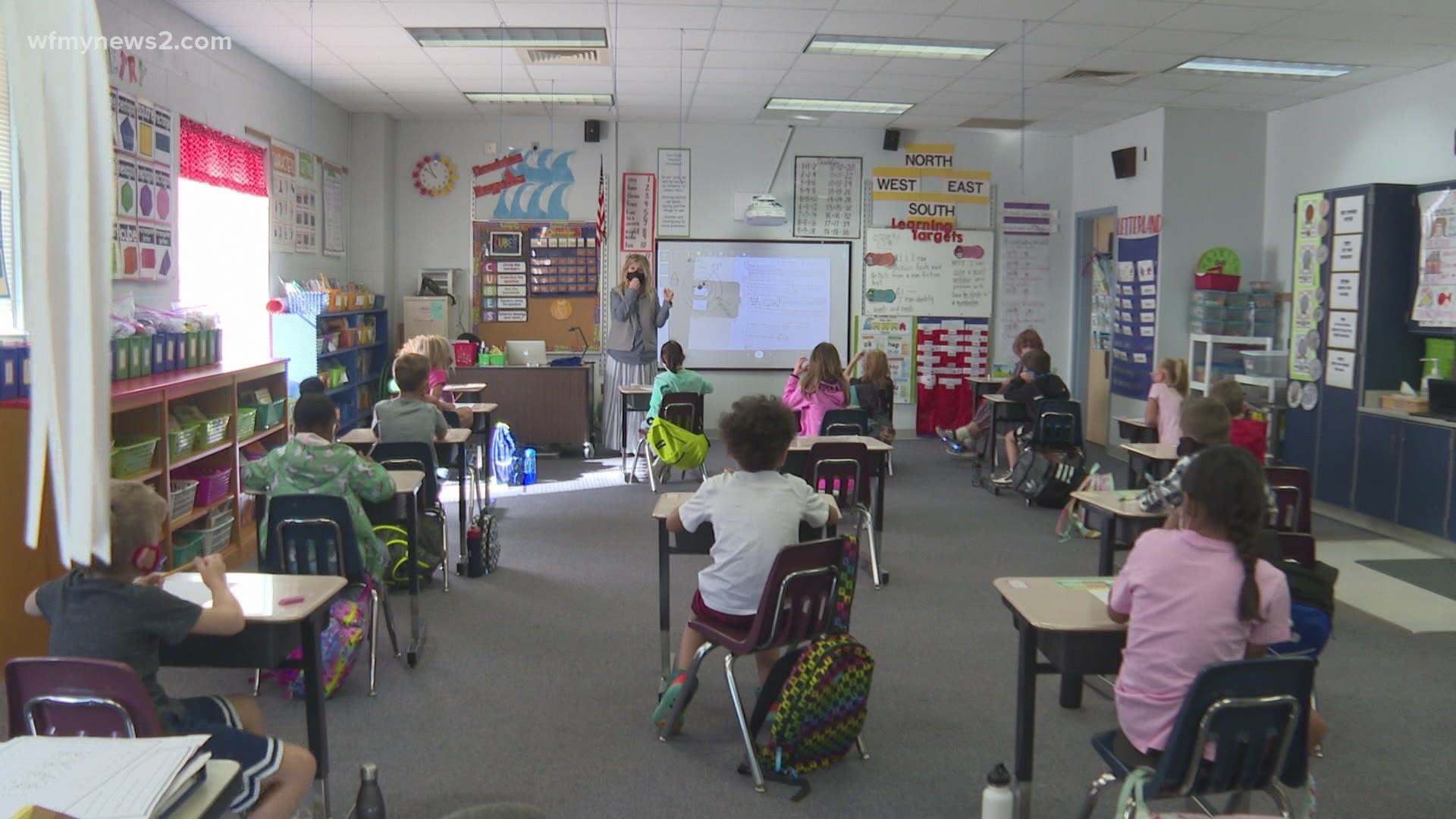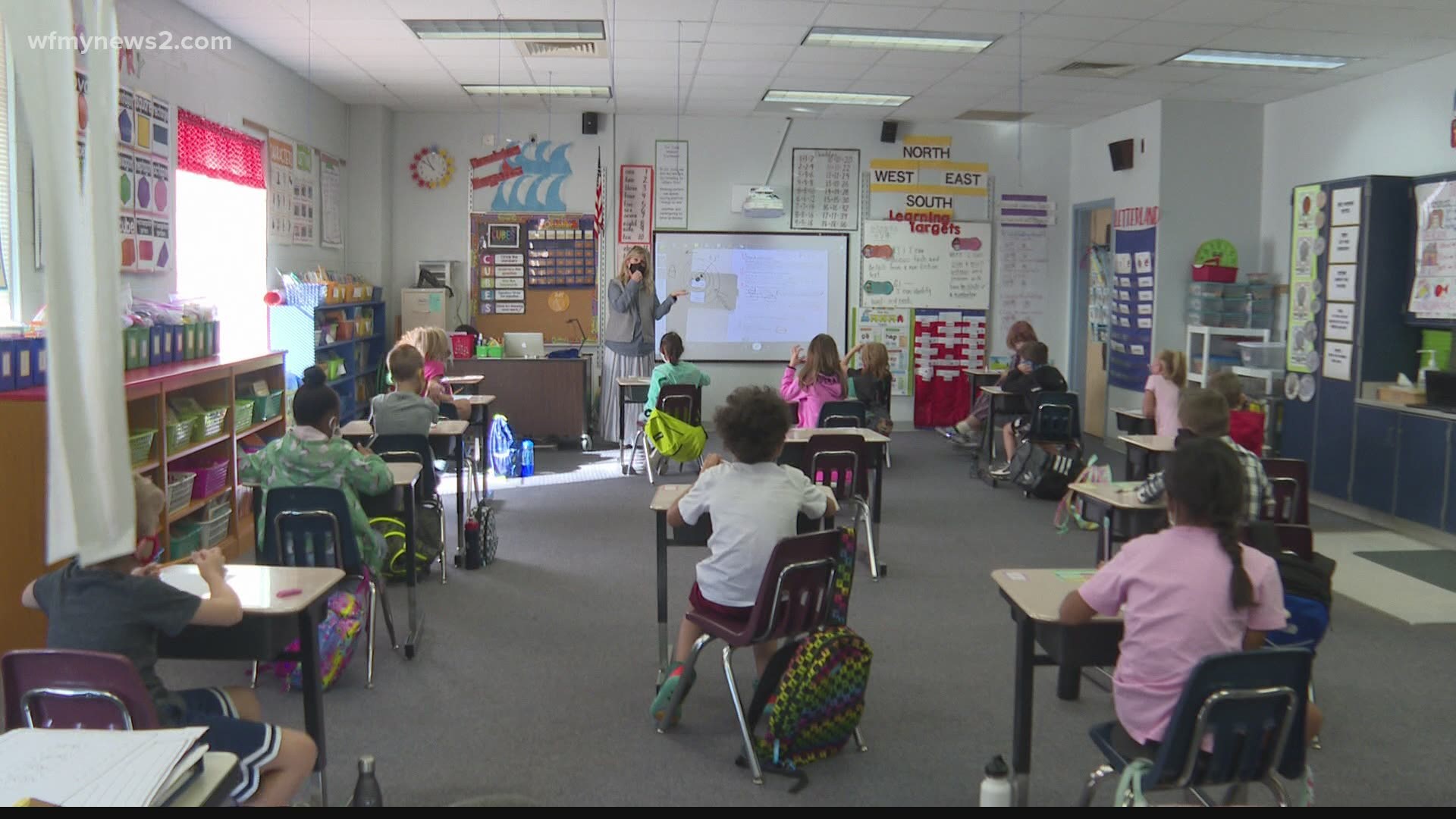MOUNT AIRY, N.C. — While other school districts are still finalizing reentry plans, one has had students in classrooms since the first day on August 17th. Mount Airy City Schools welcomed back all students and almost mid-way through the school year, they have had no COVID-19 outbreaks or clusters. The district let WFMY News 2's Maddie Gardner inside one of their schools to see what's working for them.
At B.H. Tharrington Primary School, Kindergarten through Second Grade students start their day with a screening.
"Each morning as students come to the front door either off the bus or out of their cars and we have staff on hand here that will first take their temperature," Principal Emily Niston said.
They're also asked to turn in a form that their parent filled out to let me know if they've had symptoms or been exposed to anyone with COVID-19.
"So that’s kind of their ticket to the front door," Niston said.
After that, kids are led down a one-way hallway to the cafeteria to pick up breakfast and head to their classroom to eat. It's also where they'll eat lunch, the cafeteria is closed.
Every child and adult dons a mask, the floors mark off six feet of space and black plastic trash bags cover communal water fountains.
"We are trying to avoid any clusters as we get into flu season and we get into athletics starting," Dr. Kim Morrison, the district's superintendent, said.
So far, they've been successful in preventing cases. Of the more than 1,700 students in the district, 1,350 of them are learning in person and only five cases of COVID-19 have been reported. That's .4% of the students.
"Even if you had a higher percentage, you’re still not even up to 1% of your population and all of our cases have been our students since school started," Dr. Morrison said. "No staff have been infected."
Other districts are struggling to bring kids back into buildings. Dr. Morrison said she thinks it's possible to achieve the same, low numbers even in a larger district.
"It’s all about your percentage," she said. "What is the percentage of spread in the community? What is the percentage of the school? What is the percentage of the district? So, it’s the same, we just have a smaller school district with less staff so we’re just a microcosm of an urban district."
Mount Airy City Schools is one of the very few district that brought all grade levels back at the start of the school year. There are remote options for parents and teachers who were not comfortable returning to buildings. The school board voted unanimously for their return and Dr. Morrison said the community wanted it. So much so, families are transferring into the district so their kids can get in-person learning.
"Mount Airy is really unique, you know that, everybody knows the reputation of Mount Airy," Dr. Morrison said. "The community works really hard to take care of their students. They all wanted to come back so we had to work through people who are worried or scared and give them a remote option. We had to work with all of our staff and help them understand that they were safe so they could come back."
Those remote options include online classes with a teacher not in the district or a blended model with a MACS teacher in a classroom with students while also teaching students at home on Zoom.
As far as kids in schools, at B.H. Tharrington class sizes are small enough and classrooms large enough to spread kids out at least six feet. At other schools, like Mount Airy Middle School, some classes are split into two groups with a teacher in one room teaching live and broadcasting to another classroom with a second group of students and a staff member monitoring. Dr. Morrison said staff members who aren't comfortable being around students can Zoom from a separate room in the school building.
"95% of our staff chose to come back face-to-face," she said. "We did have a few that had some health concerns and they are teaching in the building but they are remote learning zooming into the kids. They’re not in the actual physical classroom they’re in the buildings zooming in with those children."
Not only does Dr. Morrison feel like school is the safest place for students, she believes bringing kids back to classrooms is safer for the entire community.
"My personal philosophy is if you have all of your children back at school and you can get your adults back to work in a safe, COVID-free environment then that’s seven and a half to eight hours a day where they are occupied in a way that is safe," Dr. Morrison said. "So they’re not going to Walmart, they’re not seeing each other, not going to each other‘s houses and they’re not doing things that are less structured and not as safe. I believe school is the safest place for students to be if your community is not seeing a huge amount of COVID."
The district has plans in place should cases pop up. They're working with the county health department to implement contact tracing.
"If we’re up to three cases that are related in anyway we would close that classroom down for 14 days," Dr. Morrison said. "If you have four cases of COVID we would look at where that is occurring. So, like, if it’s middle school and it was all eighth graders, we would close down the eighth grade."
With the exception of having to remind the occasional student to pull their mask up, Niston said this is working for their school and Dr. Morrison agrees that the plan is working for the entire district.
"We really believe that the benefits outweigh the issues that you would have if you're not at school," Dr. Morrison said. "We’re doing everything we can to avoid any kind of cluster and we’re trying to keep the rest of the students safe."


